The Master of Make Believe
by Bob Brooke
Maxfield Parrish was to the 1930s what
Peter Max was to the 1960s. The culture of the time influenced them
both. And both dealt in fantasy. While Parrish’s paintings were nearly
as colorful as Max’s, they possessed an air of elegance and
refinement—the ultimate complement to the Art Deco style.
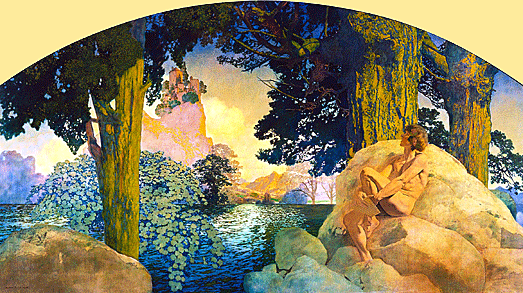
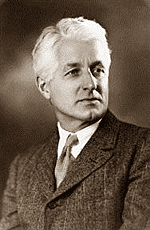 Born
in Philadelphia, Pennsylvania, Frederick Parrish was the son of painter
and etcher Stephen Parrish. His mother was Elizabeth Bancroft, who
raised him as a Quaker. Later, he adopted the maiden name of his
paternal grandmother, Maxfield, as his middle name, and later as his
professional name. He began drawing for his own amusement as a child.
His parents encouraged his talent, although early on his main interest
was in architecture. In 1884, his parents took him to England, Italy,
and France where he learned about architecture and the painting of the
old masters. During their two years of travels, Parrish studied at the
Paris school of a Dr. Kornemann. Born
in Philadelphia, Pennsylvania, Frederick Parrish was the son of painter
and etcher Stephen Parrish. His mother was Elizabeth Bancroft, who
raised him as a Quaker. Later, he adopted the maiden name of his
paternal grandmother, Maxfield, as his middle name, and later as his
professional name. He began drawing for his own amusement as a child.
His parents encouraged his talent, although early on his main interest
was in architecture. In 1884, his parents took him to England, Italy,
and France where he learned about architecture and the painting of the
old masters. During their two years of travels, Parrish studied at the
Paris school of a Dr. Kornemann.
In 1888, he began studying architecture at the Haverford School, now
Haverford College, where he attended for two years. From 1892 to 1895,
he studied under artists Robert Vonnoh and Thomas Pollock Anshutz at the
Pennsylvania Academy of the Fine Arts in Philadelphia. After graduating,
Parrish went to Annisquam, Massachusetts to share a painting studio with
father. A year later, Parrish audited a few classes taught by noted
illustrator Howard Pyle at the Drexel Institute of Art, Science &
Industry. But Pyle told him he had nothing left to teach him, and soon
Parrish agreed.
Parrish’s Artistic Career
After graduation, Parrish began an artistic career that lasted over 50
years. During that time, he produced nearly 900 works of art, including
calendars, greeting cards, and magazine covers.
 In
1885, his work appeared on the Easter edition of Harper’s Bazaar. He
also did work for other publications. In addition to his magazine work,
he also illustrated a children's book in 1897, Mother Goose in Prose
written by L. Frank Baum. By 1900, Parrish had become a member of the
Society of American Artists. And in 1903, he traveled to Italy. In
1885, his work appeared on the Easter edition of Harper’s Bazaar. He
also did work for other publications. In addition to his magazine work,
he also illustrated a children's book in 1897, Mother Goose in Prose
written by L. Frank Baum. By 1900, Parrish had become a member of the
Society of American Artists. And in 1903, he traveled to Italy.
Parrish worked as a freelance commercial artist until the 1920s. His
commissions included many prestigious projects, among them Eugene
Field's Poems of Childhood in 1904 and Tales of the Arabian Nights in
1909. Parrish’s illustrations also appeared in A Wonder Book and
Tanglewood Tales in 1910, The Golden Treasury of Songs and Lyrics in
1911, and The Knave of Hearts in 1925.
By 1910, Parrish earned over $100,000 a year by 1910, a phenomenal
amount even by today’s standards. Back then homes sold for $2,000.
Some of Parrish’s earliest color paintings became illustrations in The
Century Magazine. Though he did some other early color illustrations,
most were black and white drawings with color oil glazes added to prints
of the originals.
From 1900 to 1910, the techniques of color reproduction varied quite a
bit. It was still an art and individual printers varied widely in their
skills. The invention of "process" color, in which a painting was
photographically "separated" into three colors—cyan, magenta, and
yellow—plus black, paved the way for more consistent reproduction.
Parrish, like many other artists experimented with the best painting
techniques to accommodate these new methods. What Parrish did was a
result of printing methods and gave his works a unique 'feel' and
luminosity.
Parrish’s Technique
Parrish suffered from tuberculosis for a time in 1890. While ill, he
discovered how to mix oils and glazes to create vibrant colors. He would
first mentally assess the blue of a composition and painted it directly
onto a base of white paper or gesso in a thin, transparent glaze. He
then painted other colored glazes over this. When he shined light on his
painting, it would penetrate the transparent glazes, reflect off the
white base and mix the final colors in a brilliant manner impossible to
achieve with mixed pigments.
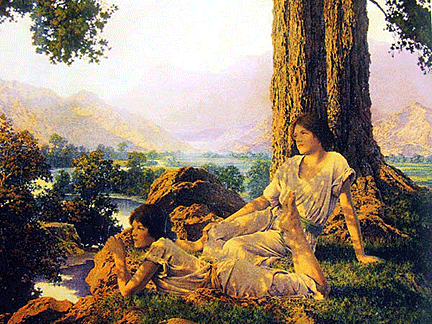 By
1900, Parrish had established himself as a professional artist and
illustrator and became a member of the Society of American Artists.
Magazine covers became a perfect showcase for his luminous paintings.
Colliers took major advantage of this. Other magazines like Scribners
and Century often featured Parrish in the lead spot with a color
frontispiece in addition to the occasional cover. Whilel still others
used Parrish’s art, including Harpers Weekly, Hearst's, Ladies' Home
Journal, Life, McClures, and many more. By
1900, Parrish had established himself as a professional artist and
illustrator and became a member of the Society of American Artists.
Magazine covers became a perfect showcase for his luminous paintings.
Colliers took major advantage of this. Other magazines like Scribners
and Century often featured Parrish in the lead spot with a color
frontispiece in addition to the occasional cover. Whilel still others
used Parrish’s art, including Harpers Weekly, Hearst's, Ladies' Home
Journal, Life, McClures, and many more.
He would take photographs of models in black and white and project the
image onto his works. This technique allowed for his figures to be
clothed in geometric patterns, while accurately representing distortion
and draping. This technique gave his paintings a more three-dimensional
feel. He carefully calculated the outer proportions and internal
divisions of his compositions in accordance with geometric principles
such as root rectangles and the golden ratio.
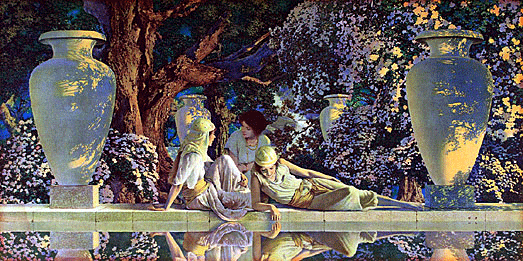
Parrish wove a magical world, using the color lapis lazuli in its purest
form. In fact, the color “Parrish blue” was named after him. His
idealized the beauty of the female form adorned in classical gowns with
backgrounds of electric violets, radiant reds and rich glowing earth
tone pigments, created an idyllic world indeed. Other images had scenes
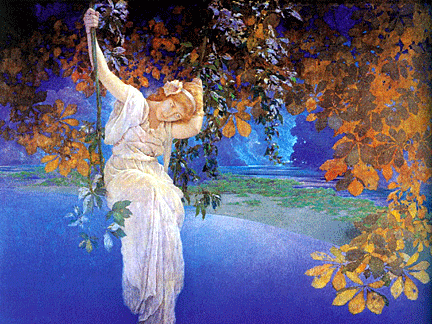 embellished
with billowing clouds in a fairy tale ambience of maidens and knights
lying under porticoes and these were equally harmonic, idealistic, and
beloved. embellished
with billowing clouds in a fairy tale ambience of maidens and knights
lying under porticoes and these were equally harmonic, idealistic, and
beloved.
As a result of this ability to create such a sublime splendor, Maxfield
Parrish became unquestionably the most successful and best-known
American illustrator of the early part of the 20th century. His images
were too realistic not to be believed. Their stark beauty and superb
execution denied viewers any ability to question their existence. They
were photographic, mechanical and above all, technically accurate.
Parrish’s Prints
While books and magazines provided him with an enormous public
following, it was his prints and calendars that gave him the greatest
exposure. It started in 1904 with reproductions of 'Air Castles',
created from a Ladies' Home Journal cover, and continued through 1920
with prints from previously published pieces. His prints of images
created for candy box lids had fueled the public interest. In the 1920s,
Parrish turned his back on illustration and focused on painting. The
first such image was “Daybreak,” which eventually became his
masterpiece. Produced in 1923, it features female figures in a landscape
scene.
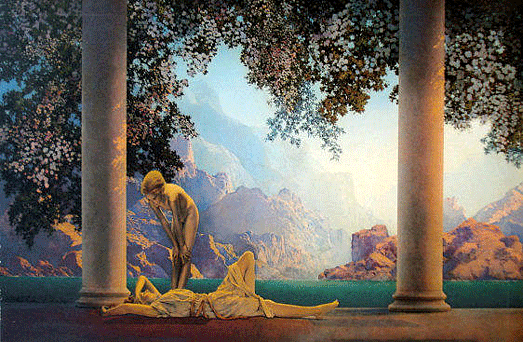
More lightly clothed lasses in mock-classical settings followed. The
public couldn't get enough. With the exception of his justly famous
Knave of Hearts book in 1925, the remainder of Parrish's career was
mainly spent painting these popular images and a series of sumptuous
landscapes for Brown & Bigelow calendars published from 1937 through
1962.
Magazine Work
 Parrish
worked for popular magazines throughout the 1910s and 1920s, including
Hearst's and Life. He also created advertising for companies like
Wanamaker's, Edison-Mazda Lamps, Colgate and Oneida Cutlery. Parrish
worked with Collier's from 1904 to 1913. He received a contract to deal
with Collier’s Magazine exclusively for six years. He also painted
advertisements for D.M. Ferry Seed Company in 1916 and 1923, which
helped him gain recognition in the eye of the public. Parrish
worked for popular magazines throughout the 1910s and 1920s, including
Hearst's and Life. He also created advertising for companies like
Wanamaker's, Edison-Mazda Lamps, Colgate and Oneida Cutlery. Parrish
worked with Collier's from 1904 to 1913. He received a contract to deal
with Collier’s Magazine exclusively for six years. He also painted
advertisements for D.M. Ferry Seed Company in 1916 and 1923, which
helped him gain recognition in the eye of the public.
In 1931, Parrish declared to the Associated Press, "I'm done with girls
on rocks", and chose instead to focus on landscapes. He was also an avid
machinist, and often referred to himself as "a mechanic who loved to
paint." By 1935, Parrish painted landscapes exclusively.
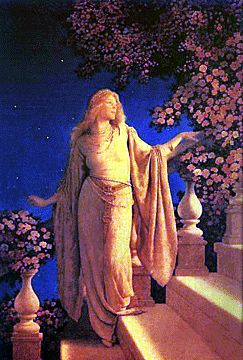 In
2006, “Daybreak” sold for US$7.6 million. The National Museum of
American Illustration claims the largest body of his work in any
collection, with 69 works by Parrish. The Hood Museum of Art in Hanover,
New Hampshire, the Cornish Colony Museum in Windsor, Vermont, and the
Metropolitan Museum of Art in New York, all own some of his works. In
1925, one out of every four households in the United States had a copy
of one of his art prints hanging on their walls. In
2006, “Daybreak” sold for US$7.6 million. The National Museum of
American Illustration claims the largest body of his work in any
collection, with 69 works by Parrish. The Hood Museum of Art in Hanover,
New Hampshire, the Cornish Colony Museum in Windsor, Vermont, and the
Metropolitan Museum of Art in New York, all own some of his works. In
1925, one out of every four households in the United States had a copy
of one of his art prints hanging on their walls.
After a long and self-satisfied life, Parrish died on March 30, 1966, at
his home and studio, ‘The Oaks’ in Plainfield, New Hampshire at the age
of 95. His artistic career had ended six years earlier upon hearing of
the marriage of his mistress Susan Lewin.
Even the great American illustrator, Norman Rockwell, considered
Maxfield Parrish to be his idol.
<
More Special Features
Next Article > |
